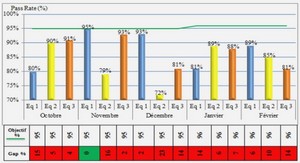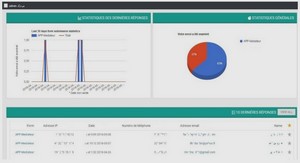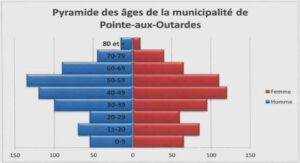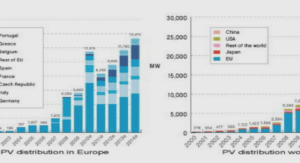Article présenté à IEEE Globecom 2008
This paper is devoted to the study of the ergodic capacity of frequency selective MIMO systems equipped with a MMSE receiver when the channel state information is available at the receiver side and when the second order statistics of the channel taps are known at the transmitter side. As its expression is rather complicated and dicult to analyse, it is studied in the case where the number of transmit and case where the transmit antennas are correlated. It is shown that the left singular eigenvectors of the optimum precoder coincide with the eigenvectors of the mean of the channel taps transmit covariance matrices, and its singular values are solution of a certain minimization problem. It is now well established that using multiple transmit and receive antennas po- tentially allows to increase the Shannon capacity of digital communications systems. Since the seminal work of Teletar ([1]), the ergodic Shannon capacity of block fa- ding MIMO systems has been studied extensively. If the channel state information is available at the receiver side while the transmitter is only aware of its second order statistical properties, important questions such as the impact of channel correlations on the capacity or the design of optimal precoding schemes have been addressed by several authors (see e.g. [31] for a review).
The ergodic Shannon capacity is certainly a valuable gure of merit if the MIMO system under consideration is equipped with a maximum likelihood decoder. As this receiver may be dicult to use in practice, in particular if the MIMO channel is frequency selective, it is also quite relevant to study the potential performance of MIMO systems equipped with suboptimum linear interfaces. In this paper, we consider the MMSE receiver, and study the corresponding ergodic capacity deno- this context, the design of an optimum precoder has been addressed in a number of papers (see e.g. [8]). However, assuming that the transmitter is aware of the channel state information is often not realistic in the context of mobile wireless systems. In this paper, we assume that the MIMO channel is frequency selectiven, known at the receiver side, but that its second order statistics of the channel are available at the transmitter side. As in [9], the channel taps are modelled as independent Gaussianin the case where the number of transmit and receive antennas converge to +∞ at the same rate. In this asymptotic regime, Cmmse has the same behaviour that a simpler term Cmmse. As observed in a number of situations, Cmmse is a reliable aprroximation of Cmmse, even for a realistic number of transmit and receive anten- nas. We show that the transmission scheme for which Cmmse is optimum is a (non frequency dependent) linear precoding. We address the optimization of Cmmse w.r.t. the precoder, and show that the left singular vectors of the optimum precoder(s).
where p represents the total received power per receive antenna and where Hl is a zero mean complex Gaussian matrix with unit variance independent identically distributed (i.i.d.) entries. Matrix Cl is a positive matrix modelling the impact of t TrC = 1. These normalizations ensure that the total received poweris independent of L and t and thus allows to compare in a fair fashion situations in which the number of paths and the number of transmit antennas dier. Model (7.1) towards deterministic terms which only depend on the statistical properties of H(e2iπf ). By (7.2), the second order statistical properties of H(e2iπf ) are independent of the frequency f . Therefore, the large system approximation of the entries Q(e2iπf ) are independent of f . More precisely, it is possible to prove the following theorem.Theorem 4 shows that the determination of an optimal precoder Kopt needs to solve the optimization Problem 1. This problem cannot be solved in closed form, except if D = I. In this context, the results of [7] imply that the solutions of Problem 1 are the vectors γopt = (γ1,opt, . . . , γt,opt) whose s largest components coincide withj=1 log2(1 + γjδ(Λ)) is not guaranteed because, as explained above, this last function is in general not concave. However, we have checked if D = I, then the gradient algorithm always converges towards one of the above mentioned global maximum.In order to illustrate the impact of the precoder optimization on Cmmse and Cmmse in a realistic context, we follow the propagation model introduced in [9] in which each path corresponds to a scatterer cluster characterized by a mean angle.




